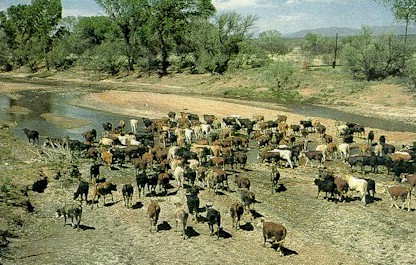|
| |
Streams
Need Riparian Zones
The many trees and plants in the riparian zone aid in the stabilization of riverbank
soil. Much like the steel reinforcement rods found in concrete bridges, trees and plants along streambanks and lakeshores reduce
soil erosion by their roots holding the soil together, making it more difficult for waves,
currents and runoff to wash the soil away. Plants further prevent erosion by
reducing the impact of raindrops on exposed soil. The result is a decreased input of
sediment and suspended solids in the stream.

Big Darby Creek, which flows through
agricultural land in central Ohio, benefits from a regional effort to protect its riparian
zone; Jay DeLong photo
|
Riparian zones help retain floodwater after heavy rains or
snowmelts. These streamside wetlands mimic huge sponges absorbing and filtering water,
which reduces peakflow levels in streams, and
replenishes the groundwater that helps maintain lake levels and stream flows. As
runoff water moves through trees and other plants, leaves and twigs, it slows and drops
sediment that has been carried along. Since these sediments are deposited on the
banks rather than in the streams, floods can actually be bank-building events. This
settling process also keeps nutrients from flowing into streams and lakes, permitting
plant roots to take up the nutrients that have dissolved in the runoff and soaked into the
soil, reducing the amount of pollution flowing into lakes and streams. |
Because the soil is exceptionally fertile,
riparian areas can produce stands of very large trees. This makes them desirable as
timber sources. But because of the crucial functions these trees serve, riparian
areas are not suitable for logging. These areas are sensitive
to other activities and disturbances as well: excessive livestock grazing, agriculture,
road-building, urban development, and recreation. Estimates of the percentage of
riparian areas that have been altered in the United States range from 70-90%. The extent of riparian-area alterations and resulting problems varies throughout
North America, but the areas generally most heavily impacted have been in the... The extent of riparian-area alterations and resulting problems varies throughout
North America, but the areas generally most heavily impacted have been in the...
| southeastern... |
|

Highly eroded stream bank of Short Creek,
Mississippi; Bruce Stallsmith photo |
Streams throughout much of the SE U.S. show such signs of past
logging and poor land use practices.
"Massive logging across the southeast is
very likely in the next two decades", according to Southeastern
Fishes Council Regional Reports - 2000  , which also stated: , which also stated:
"We know logging the last 100-year stand in the
southeast caused tremendous erosional problems in creeks and rivers...The ensuing erosion
was tremendous, particularly in the upper Piedmont where soils are generally very
erodible. While modern operations do not use splash dams or cut down every tree, the
sheer scope of operations and rate of timber removal will create tremendous stressors on
fishes and habitats." |
|
| midwestern... |

Eroded bank of Walnut Creek, Iowa; Keith E. Schilling
and Calvin F. Wolter photo
|
|
The negative effects of intensive agricultural practices are
visible in streams in the forms of silt, fertilizers and pesticides. Streams then move
these materials to rivers and estuaries and out to the floodplain during high-water
inundation. The
nutrients, especially nitrogen and phosphorous, can create locally high nutrient
concentrations, low dissolved oxygen levels, pollution and fish kills. This is
presently the case in the Mississippi Delta and Chesapeake Bay.
One study  found that a three-tiered riparian
zone in Iowa was effective in removing the herbicide atrazine from cropland runoff.
Researchers in other studies found that most of the herbicides atrazine, alachlor,
trifluralin, and 2,4-D could be removed by riparian vegetation. found that a three-tiered riparian
zone in Iowa was effective in removing the herbicide atrazine from cropland runoff.
Researchers in other studies found that most of the herbicides atrazine, alachlor,
trifluralin, and 2,4-D could be removed by riparian vegetation. |
| ...and
southwestern states. |
|
|
|
Though riparian corridors in the arid western U.S. occupy less
than one percent of the land surface, an estimated 60-70% of western bird species  and as many as 80% of wildlife species
in Arizona and New Mexico and as many as 80% of wildlife species
in Arizona and New Mexico
 and in southeastern Oregon and in southeastern Oregon  are dependent on riparian habitats.
Because of the scarcity of water these areas have been heavily impacted for ranching,
agriculture, damming, water diversions and urbanization. are dependent on riparian habitats.
Because of the scarcity of water these areas have been heavily impacted for ranching,
agriculture, damming, water diversions and urbanization. Livestock grazing is considered to be
the greatest source of riparian habitat degradation in the arid regions of the western
U.S. Between 1940 and 1990, the number of cattle in the western U.S. increased from
25.5 to 54.4 million animals  and livestock grazing has damaged 80%
of the streams and riparian ecosystems there. and livestock grazing has damaged 80%
of the streams and riparian ecosystems there.  |
|

San Pedro River, AZ; U.S. Bureau of Land Management
photo |
Cattle consume streamside vegetation,
disturb soils, destabilize streambanks, churn up channel sediments, and deposit manure and
urine. One study found that a riparian zone in eastern Oregon comprised only 1.9% of the
grazing area, but produced 81% of the forage consumed by cattle. |
Rivers in northwestern North America...
© Robert Carillio s_r_enterprises@hotmail.com and Jay DeLong thirdwind@att.net
|
![]() The extent of riparian-area alterations and resulting problems varies throughout
North America, but the areas generally most heavily impacted have been in the...
The extent of riparian-area alterations and resulting problems varies throughout
North America, but the areas generally most heavily impacted have been in the...



